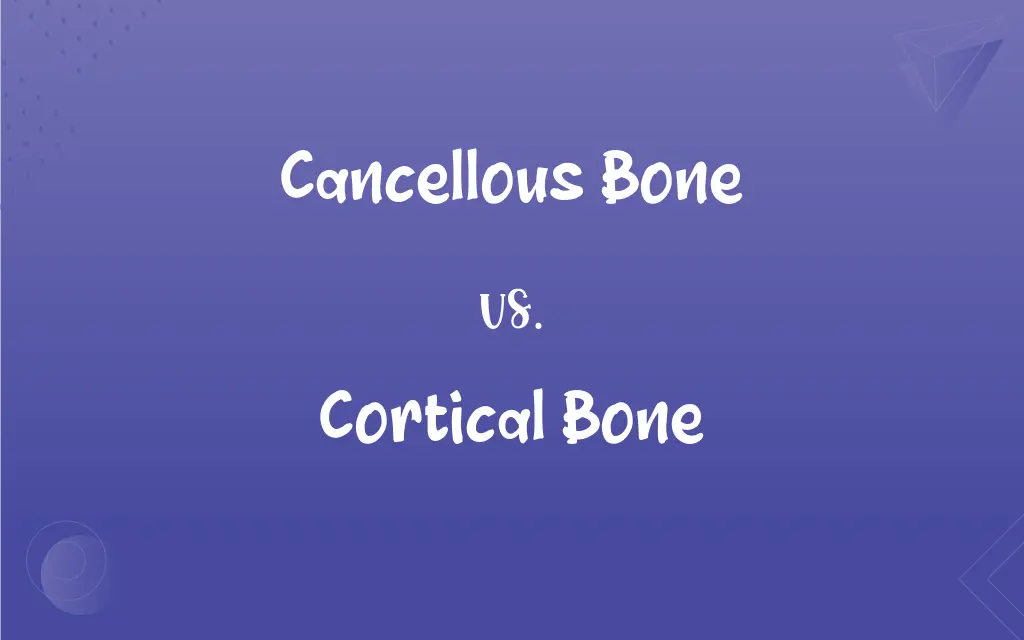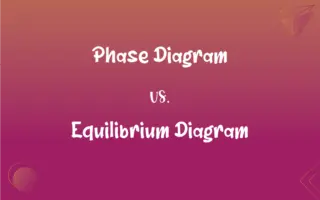Cancellous Bone vs. Cortical Bone: What's the Difference?
Edited by Aimie Carlson || By Harlon Moss || Published on February 2, 2024
Cancellous bone s spongy, porous, found inside bones. Cortical bone is dense, compact, forms the outer layer of bones.

Key Differences
Cancellous bone, also known as trabecular or spongy bone, is characterized by its porous, honeycomb-like structure. In contrast, cortical bone, also referred to as compact bone, is dense and forms the hard outer shell of bones.
The main function of cancellous bone is to absorb shock and reduce the weight of bones, making them lighter. Cortical bone, on the other hand, provides strength and structure, protecting and supporting the body.
Located mostly in the ends of long bones and in the pelvis, spine, and skull, cancellous bone contains red bone marrow, where blood cells are produced. Cortical bone is found throughout the body, making up approximately 80% of skeletal mass.
Cancellous bone has a high surface area to mass ratio, which facilitates the exchange of calcium ions and other substances. Cortical bone, with its lower surface area to mass ratio, is less involved in metabolic processes.
The architecture of cancellous bone changes throughout life, adapting to stress and trauma. Cortical bone also changes over time, but it is more resistant to bending and twisting forces.
ADVERTISEMENT
Comparison Chart
Structure
Porous, spongy
Dense, compact
Function
Shock absorption, weight reduction
Strength, support
Location
Ends of long bones, pelvis, spine, skull
Throughout the body
Role in Metabolism
High metabolic activity
Lower metabolic activity
Adaptability
Changes with stress and trauma
Resists bending, twisting
ADVERTISEMENT
Cancellous Bone and Cortical Bone Definitions
Cancellous Bone
Contains red bone marrow.
Cancellous bone is crucial for blood cell production.
Cortical Bone
Resists bending and twisting forces.
Cortical bone provides rigidity to the skeletal structure.
Cancellous Bone
Characterized by a honeycomb-like structure.
The unique structure of cancellous bone makes it effective at shock absorption.
Cortical Bone
Protects and supports the body.
The cortical bone in the skull shields the brain.
Cancellous Bone
A porous type of bone found inside bones.
The cancellous bone in the femur helps to lighten the bone's weight.
Cortical Bone
Less involved in metabolic processes.
Cortical bone's low surface area to mass ratio affects its metabolic activity.
Cancellous Bone
Adapts to stress and trauma.
Cancellous bone changes its architecture in response to physical activity.
Cortical Bone
Makes up about 80% of skeletal mass.
Cortical bone's density is a major contributor to skeletal strength.
Cancellous Bone
Found in the ends of long bones.
Cancellous bone is predominant in the ends of the humerus.
Cortical Bone
The dense outer surface of bone.
Cortical bone forms the hard exterior of the femur.
FAQs
How much of the skeleton does cortical bone constitute?
It makes up about 80% of the total bone mass.
Can cancellous bone be found in flat bones?
Yes, it's present in the interior of flat bones like the skull.
What is cancellous bone primarily made of?
It's composed of trabeculae, giving it a porous structure.
Does cancellous bone have a role in blood cell production?
Yes, it houses red bone marrow, vital for blood cell production.
Does cancellous bone change over a person's lifetime?
Yes, its architecture adapts to stress and trauma.
Where is cortical bone primarily located?
It forms the outer layer of all bones in the body.
Does cortical bone provide structural support?
Absolutely, it's crucial for structural integrity and support.
Does cortical bone have a higher density than cancellous bone?
Yes, cortical bone is much denser and harder.
Can diseases affect cancellous bone differently than cortical bone?
Yes, diseases like osteoporosis can have differing impacts.
Is cancellous bone more metabolically active?
Yes, due to its high surface area to mass ratio.
Is cancellous bone important for joint movement?
Yes, it assists in joint function and movement.
Does cortical bone have a role in protecting internal organs?
Yes, especially in bones like the skull and ribs.
How does cortical bone respond to physical activity?
It adapts slowly, becoming denser with increased activity.
Is cancellous bone present in the vertebrae?
Yes, it's a key component of vertebral structure.
Can cortical bone repair itself after a fracture?
Yes, though the process is slower compared to cancellous bone.
Does aging affect cortical bone density?
Yes, it tends to decrease with age.
Is cancellous bone more susceptible to osteoporosis?
Yes, due to its porous nature.
Does cortical bone contribute to the overall shape of the bone?
Absolutely, it defines the bone's external shape and size.
Is cortical bone involved in mineral storage?
Yes, it plays a significant role in calcium storage.
Can the proportion of cancellous to cortical bone vary in bones?
Yes, it varies depending on the bone's location and function.
About Author
Written by
Harlon MossHarlon is a seasoned quality moderator and accomplished content writer for Difference Wiki. An alumnus of the prestigious University of California, he earned his degree in Computer Science. Leveraging his academic background, Harlon brings a meticulous and informed perspective to his work, ensuring content accuracy and excellence.
Edited by
Aimie CarlsonAimie Carlson, holding a master's degree in English literature, is a fervent English language enthusiast. She lends her writing talents to Difference Wiki, a prominent website that specializes in comparisons, offering readers insightful analyses that both captivate and inform.






































































